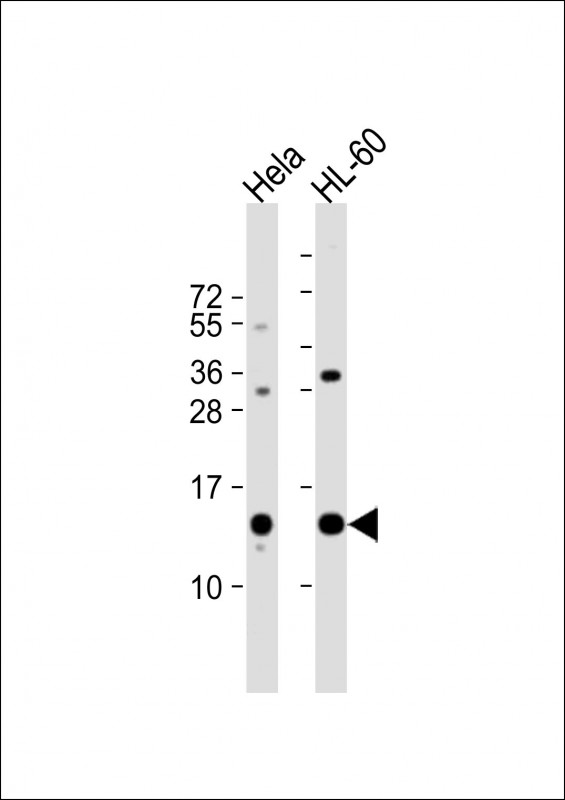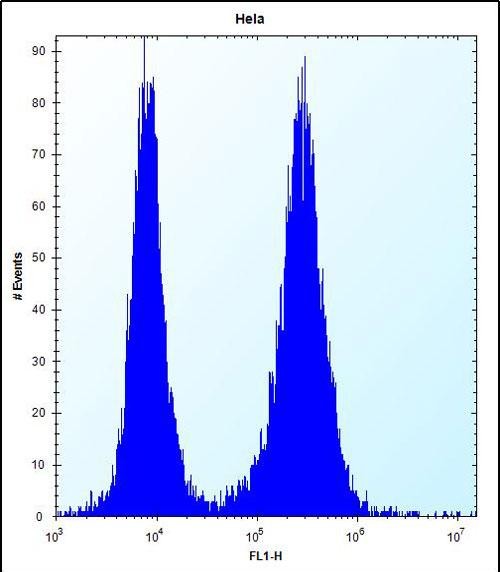PHF5A Antibody (C-term)
Affinity Purified Rabbit Polyclonal Antibody (Pab)
- SPECIFICATION
- CITATIONS
- PROTOCOLS
- BACKGROUND

Application
| FC, WB, E |
|---|---|
| Primary Accession | Q7RTV0 |
| Other Accession | P83871, P83870, NP_116147.1 |
| Reactivity | Human |
| Predicted | Mouse, Rat |
| Host | Rabbit |
| Clonality | Polyclonal |
| Isotype | Rabbit IgG |
| Calculated MW | 12405 Da |
| Antigen Region | 81-110 aa |
| Gene ID | 84844 |
|---|---|
| Other Names | PHD finger-like domain-containing protein 5A, PHD finger-like domain protein 5A, Splicing factor 3B-associated 14 kDa protein, SF3b14b, PHF5A |
| Target/Specificity | This PHF5A antibody is generated from rabbits immunized with a KLH conjugated synthetic peptide between 81-110 amino acids from the C-terminal region of human PHF5A. |
| Dilution | WB~~1:1000 FC~~1:10~50 |
| Format | Purified polyclonal antibody supplied in PBS with 0.09% (W/V) sodium azide. This antibody is purified through a protein A column, followed by peptide affinity purification. |
| Storage | Maintain refrigerated at 2-8°C for up to 2 weeks. For long term storage store at -20°C in small aliquots to prevent freeze-thaw cycles. |
| Precautions | PHF5A Antibody (C-term) is for research use only and not for use in diagnostic or therapeutic procedures. |
| Name | PHF5A |
|---|---|
| Function | Component of the 17S U2 SnRNP complex of the spliceosome, a large ribonucleoprotein complex that removes introns from transcribed pre-mRNAs (PubMed:27720643, PubMed:28541300, PubMed:12234937, PubMed:32494006, PubMed:34822310). The 17S U2 SnRNP complex (1) directly participates in early spliceosome assembly and (2) mediates recognition of the intron branch site during pre-mRNA splicing by promoting the selection of the pre-mRNA branch-site adenosine, the nucleophile for the first step of splicing (PubMed:12234937, PubMed:32494006, PubMed:34822310). Within the 17S U2 SnRNP complex, PHF5A is part of the SF3B subcomplex, which is required for 'A' complex assembly formed by the stable binding of U2 snRNP to the branchpoint sequence in pre-mRNA (PubMed:12234937, PubMed:27720643). Sequence independent binding of SF3A and SF3B subcomplexes upstream of the branch site is essential, it may anchor U2 snRNP to the pre-mRNA (PubMed:12234937). Also acts as a component of the minor spliceosome, which is involved in the splicing of U12-type introns in pre-mRNAs (PubMed:15146077, PubMed:33509932). Also involved in elongation by RNA polymerase II as part of the PAF1 complex (PAF1C) (By similarity). PAF1C is required for maintenance of embryonic stem cell (ESC) self- renewal and cellular reprogramming of stem cells (By similarity). Maintains pluripotency by recruiting and stabilizing PAF1C on pluripotency genes loci, and by regulating the expression of the pluripotency genes (By similarity). Regulates the deposition of elongation-associated histone modifications, including dimethylated histone H3 'Lys-79' (H3K79me2) and trimethylated histone H3 'Lys-36' (H3K36me3), on PAF1C targets, self-renewal and pluripotency genes (By similarity). Regulates RNA polymerase II promoter-proximal pause release of the PAF1C targets and self-renewal genes, and the levels of elongating ('Ser-2' phosphorylated) RNA polymerase II in their gene bodies (By similarity). Regulates muscle specification in adult stem cells by stabilizing PAF1C in chromatin to promote myogenic differentiation (By similarity). Acts as a transcriptional regulator by binding to the GJA1/Cx43 promoter and enhancing its up-regulation by ESR1/ER-alpha (By similarity). |
| Cellular Location | Nucleus. Nucleus speckle {ECO:0000250|UniProtKB:P83870} |

Thousands of laboratories across the world have published research that depended on the performance of antibodies from Abcepta to advance their research. Check out links to articles that cite our products in major peer-reviewed journals, organized by research category.
info@abcepta.com, and receive a free "I Love Antibodies" mug.
Provided below are standard protocols that you may find useful for product applications.
Background
This gene encodes a subunit of the splicing factor 3b protein complex. Splicing factor 3b, together with splicing factor 3a and a 12S RNA unit, forms the U2 small nuclear ribonucleoproteins complex (U2 snRNP). The splicing factor 3b/3a complex binds pre-mRNA upstream of the intron's branch site in a sequence-independent manner and may anchor the U2 snRNP to the pre-mRNA. The protein encoded by this gene contains a PHD-finger-like domain that is flanked by highly basic N- and C-termini. This protein belongs to the PHD-finger superfamily and may act as a chromatin-associated protein. This gene has several pseudogenes on different chromosomes.
References
Kuwasako, K., et al. Proteins 71(4):1617-1636(2008)
Will, C.L., et al. RNA 10(6):929-941(2004)
Collins, J.E., et al. Genome Biol. 5 (10), R84 (2004) :
Will, C.L., et al. EMBO J. 21(18):4978-4988(2002)
Zhou, Z., et al. Nature 419(6903):182-185(2002)
If you have used an Abcepta product and would like to share how it has performed, please click on the "Submit Review" button and provide the requested information. Our staff will examine and post your review and contact you if needed.
If you have any additional inquiries please email technical services at tech@abcepta.com.













 Foundational characteristics of cancer include proliferation, angiogenesis, migration, evasion of apoptosis, and cellular immortality. Find key markers for these cellular processes and antibodies to detect them.
Foundational characteristics of cancer include proliferation, angiogenesis, migration, evasion of apoptosis, and cellular immortality. Find key markers for these cellular processes and antibodies to detect them. The SUMOplot™ Analysis Program predicts and scores sumoylation sites in your protein. SUMOylation is a post-translational modification involved in various cellular processes, such as nuclear-cytosolic transport, transcriptional regulation, apoptosis, protein stability, response to stress, and progression through the cell cycle.
The SUMOplot™ Analysis Program predicts and scores sumoylation sites in your protein. SUMOylation is a post-translational modification involved in various cellular processes, such as nuclear-cytosolic transport, transcriptional regulation, apoptosis, protein stability, response to stress, and progression through the cell cycle. The Autophagy Receptor Motif Plotter predicts and scores autophagy receptor binding sites in your protein. Identifying proteins connected to this pathway is critical to understanding the role of autophagy in physiological as well as pathological processes such as development, differentiation, neurodegenerative diseases, stress, infection, and cancer.
The Autophagy Receptor Motif Plotter predicts and scores autophagy receptor binding sites in your protein. Identifying proteins connected to this pathway is critical to understanding the role of autophagy in physiological as well as pathological processes such as development, differentiation, neurodegenerative diseases, stress, infection, and cancer.



